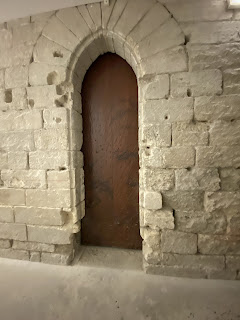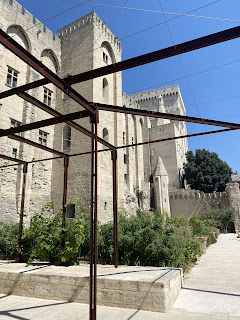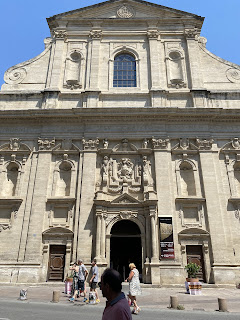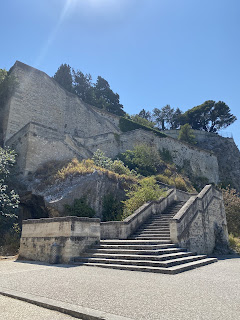I spent the day in Avignon, within the walls of the Old City. My goal was to see the Palace of the Popes and to enjoy some food from the Provence area of France.
Avignon has been in the history books for a very long time. It was first settled by the Cavares nearly 3000 years ago who found the Rhône river and the hilltop crest an inviting spot. They called the settlement Auoenion, a combination of two Celtic words; aouen (whirlpool) and ion (lord) - Lord of the Waters. Then the Romans settled here enlarging the port and the city and called it Avenius. Avenius was so important to the area that is was besieged time and time again by various groups - the Saracens, the Franks, Burgundians, Ostrogoths, and again by the Franks. In the 8th Century the Moors, having conquered much of the entire Iberian Peninsula came to Avignon, and although occupation of the city only lasted for 3 years from 734-737, it endured a complete destruction of nearly everything left standing. The battle was so bloody that one of the roads in Avignon is still referred to as Rue Rouge to describe it.
Avignon existed for the next 500 years in obscurity. Then in 1309, the Papal Court moved from Rome to Avignon. Constant bickering between the various Bishops in Rome and various factions that had arisen (this will become known as the Great Schism between the East and West branches of Catholicism) that it was impossible for the Pope to reign within the Eternal City of Rome. After the death of Pope Benedict XI, the Archbishop of Bordeaux, Bertrand de Got, was elected Pope, taking the name Clement V. One of his strongest supporters was Philip the Fair, King of France, who had used his influence to have de Got elected with an eye toward benefiting the French throne. The newly elected pope refused to have his coronation in Rome and instead had it held in Lyon. Clement V chose to have his official residence in Venaissin. But his successor, John XXII wanted a more fitting seat for the Throne of St Peter, and left the countryside that Clement V loved so much and settled in Avignon. In 1348, Clement VI purchased the entire town from Queen Giovanni I of Sicily for 80,000 florins. Thus began the period that has been known as the Avignon Papacy, also known as the Avignon Captivity or the Babylonian Captivity (from the title given to it by Martin Luther in 1520).
7 Popes, all French, reigned in Avignon for nearly the next 100 years. (There were two more of duplicate or illegitimate Popes who also reigned here). Under their papacies, Avignon was fortified with bastions, an immense castle, and the papal residence. The court at Avignon became one of the most magnificent courts recorded in all of medieval Europe. Unlike other periods in history, Jews and other non-Christians living in the area were not persecuted, instead they simply had to pay a special tax to be left in peace. By 1378 the influence of the King of France became so great that a movement began to return the Papacy to Rome. The election of Bartolommeo Prignano, Archbishop of Bari, who took the name Urban VI, was immediately contested. The French cardinals held a meeting and declared his election null and void and elected Robert of Geneva, who took the name Clement VII, and set up his court in Avignon. Later known as the anti-pope and the beginning of the division of the Christian world. A third pretender to the Papal throne was also elected during this time, Alexander V). All factions excommunicated and denounced the jurisdiction of the others. It wasn’t until 1414, after long negotiations, complicated bargaining that a solution took place in the election of a jointly elected pope, Martin V. It was only then that the Papacy was fully restored to Rome and ended the years at Avignon. Over the centuries since, Avignon, simply grew and prospered as a trading city, flourishing with churches, monuments, and hotels. Only one other event occurred that nearly wiped out the town. The plague of 1721 which killed three-quarters of the entire population - 18,000 of the 24,000 inhabitants.
Here are my pictures from today which includes pictures of the Palace of the Popes, several prominent churches in the town and the synagogue (all of them were closed), and the fortress wall.






































































No comments:
Post a Comment